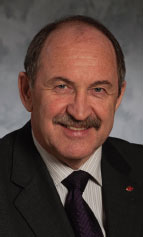 Dr. Ronald G. Smith
Dr. Ronald G. Smith
The arrival of summer, with its road trips to cottages and campgrounds, evokes images of the beautiful small towns that dot the landscape of this great country. As a long-time resident of one such small town, I consider myself fortunate to know that these areas have far more to offer than what can be experienced as a tourist. Unfortunately, people living in some of the more rural or remote regions of Canada may find it increasingly difficult to access oral care unless more dentists choose to practise in these locations.
The dental workforce in Canada is not distributed equally across the country. According to a 2007 report by the Canadian Institute for Health Information, only 11% of Canada's dentists were located in rural and small-town areas of the country, compared with almost 21% of the general population. While we are not the only health care sector where this human resource issue exists, dentistry should take positive actions to prevent a further imbalance. Dentists currently practising in these rural and more remote areas are having difficulty finding colleagues willing to take over successful existing practices. I have seen this issue firsthand and have heard much anecdotal evidence from colleagues and dental practice brokers about this problem.
It puzzles me why younger dentists are not considering these smaller centres when deciding where to associate or purchase a dental practice. Economic market forces dictate that practices up for sale in these areas would be far more affordable than those in large urban areas. Costs involved in operating the practice—not to mention cost-of-living expenses—would also be lower.
When younger dentists have come to my small BC town of Duncan (population: 5000) for locums or internships, I have always tried to convey how appealing the lifestyle can be. The pace and quality of life are very desirable. As well, serving the people as a dentist allows you to earn the respect of the community. You can hold a position of prominence within the area, because if you treat your patients with respect, they will, in turn, hold you in high regard.
So how can the dental profession make a concerted effort to encourage more dentists to consider serving communities located outside large urban areas?
Many provincial dental associations are implementing mentoring programs that allow experienced dentists to pass along to their younger colleagues some of the valuable professional knowledge they have learned—including messages about the opportunities that exist outside of urban centres.
We can also take positive actions beginning at our dental schools. The Office of the Chief Dental Officer convened a workshop in May 2010, to examine how human resource issues will impact access to care in remote communities. Participants included representatives from CDA, the dental faculties, dental regulators, government agencies and committees, public health, the Assembly of First Nations, and dental therapist and assistant organizations.
There was agreement at the workshop on the need to increase awareness at dental schools of the social and moral responsibility of providing oral care in rural and remote locations. It was also proposed that the selection criteria for dental students be reviewed to determine if factors other than grades (such as previous volunteer or humanitarian experiences or working with vulnerable populations) should be given more prominence in the application process. The CDA Board of Directors has agreed to bring the issue of the provision of service in rural areas to an upcoming Dentistry Leader's Forum for further discussion.
Clearly there is no simple solution to such a multi-faceted problem. I would personally urge younger dentists to consider setting up practice in areas outside of major urban areas. Living and practising in these areas has been an enriching and rewarding part of my life, and I hope others will choose to serve these communities in the future.
